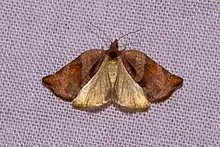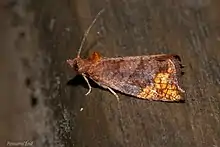Pyrgotis eudorana
Pyrgotis eudorana is a species of moth of the family Tortricidae. It is endemic in New Zealand and has been observed in both the North and South Islands. However it is regarded as a rare insect. This species inhabits native forest. Larvae exclusively feed on Muehlenbeckia australis and adults are on the wing from November to April. Adults are attracted to light.
| Pyrgotis eudorana | |
|---|---|
 | |
| Female | |
 | |
| Male | |
| Scientific classification | |
| Domain: | Eukaryota |
| Kingdom: | Animalia |
| Phylum: | Arthropoda |
| Class: | Insecta |
| Order: | Lepidoptera |
| Family: | Tortricidae |
| Genus: | Pyrgotis |
| Species: | P. eudorana |
| Binomial name | |
| Pyrgotis eudorana | |
Taxonomy
.jpg.webp)
This species was first described by Edward Meyrick in 1885 using a female specimen collected at New Plymouth in February.[2][3] Later that year Meyrick gave a more detailed description of the species.[4] Meyrick, in 1911, described the male of the species.[5] In 1928 George Hudson discussed and illustrated this species in his publication The butterflies and moths of New Zealand.[6] In both 1971 and again in 1988 J. S. Dugdale confirmed the placement of this species within the genus Pyrgotis.[7][3] The female holotype specimen is held at the Natural History Museum, London.[3]
Description
Meyrick described the adult female of this species as follows:
Female.—20 mm. Head, palpi, and thorax purplish-ochreous. Antennae ochreous-whitish. Abdomen and legs yellow-whitish, anterior and middle pair suffused with reddish-fuscous. Forewings broad, oblong, costa anteriorly very strongly arched, apex round-pointed, produced, hindmargin strongly sinuate, hardly oblique; purplish-ochreous, obscurely strigulated with greyish-purple; a slightly darker purplish basal patch, its outer edge extending from 1⁄5 of costa to 2⁄5 of inner margin, not angulated; central fascia straight, broad throughout, greyish purple, suffused with bright reddish-ochreous on upper half posteriorly, running from middle of costa to anal angle; a more distinct strigula from 3⁄4 of costa to hindmargin below middle: cilia rather dark fuscous purplish. Hindwings yellow-whitish, towards apex more yellowish, somewhat spotted with pale grey towards inner margin; cilia yellow-whitish. A handsome species, readily known by the different form of wing, straight outline of basal patch, and broad central fascia; the costa is very much more strongly arched anteriorly than in any other species.[4]
In 1911 Meyrick described the adult male of the species as follows:
♂. 18mm. Head and thorax reddish-ochreous-fuscous, thoracic crest ferruginous-ochreous. Antennal ciliations 1. Abdomen whitish-grey, anal tuft ochreous-whitish. Forewings rather elongate-triangular, costa gently arched, with moderate costal fold reaching 2⁄5, apex obtuse, termen slightly sinuate, somewhat oblique; fuscous-purplish indistinctly strigulated with dark grey; costal fold brownish-ochreous strigulated with grey; a triangular apical ochreous-orange patch, marked with some dark-fuscous strigulae between veins and on costa, its anterior edge straight, running from 3⁄5 of costa to tornus; central fascia indicated as an evenly broad band of darker suffusion preceding this: cilia reddish-ochreous-fuscous. Hindwings pale grey, apical half ochreous-whitish; cilia ochreous-whitis, on lower half of termen basally spotted with light grey.[5]
Distribution
This species is endemic to New Zealand.[8] It has been observed in both the North and South Islands at locations such as Taranaki, Lake Horowhenua, Kaitoki, Wellington, and Dunedin.[6][9] It is regarded as being rare.[6][10]
Habitat
This species inhabits native forest.[6]
Behaviour
Adults of this species are on the wing in November to April with the species appearing to be most abundant in December.[6][11] This species has been collected via a black light trap.[10]
Host species
_Meisn._(AM_AK359802-3).jpg.webp)
P. eudorana larvae feed exclusively on Muehlenbeckia australis.[7]
References
- "Pyrgotis species". www.tortricidae.com. Todd Gilligan. Retrieved 16 January 2017.
- Edward Meyrick (1885). "Tortricina (supplementary). Additions to former paper. Abstract". New Zealand Journal of Science. 2: 148. Wikidata Q110920520.
- John Stewart Dugdale (23 September 1988). "Lepidoptera - annotated catalogue, and keys to family-group taxa". Fauna of New Zealand. Department of Scientific and Industrial Research. 14: 172. doi:10.7931/J2/FNZ.14. ISSN 0111-5383. Wikidata Q45083134.
- Edward Meyrick (May 1885). "Art. XIII. — Descriptions of New Zealand Micro-Lepidoptera". Transactions and Proceedings of the New Zealand Institute. 17: 143. ISSN 1176-6158. Wikidata Q110920492.
- E. Meyrick (1 July 1911). "Notes and Descriptions of New Zealand Lepidoptera". Transactions and Proceedings of the New Zealand Institute. 43: 62. ISSN 1176-6158. Wikidata Q58200989.
- George Vernon Hudson (1928), The butterflies and moths of New Zealand, Illustrator: George Hudson, Wellington, p. 219, LCCN 88133764, OCLC 25449322, Wikidata Q58593286
{{citation}}: CS1 maint: location missing publisher (link) - J. S. Dugdale (10 November 1971). "Entomology of the Aucklands and other islands south of New Zealand: Lepidoptera, excluding non-crambine Pyralidae" (PDF). Pacific Insects Monographs. 27: 164. ISSN 0078-7515. Wikidata Q64006453.
- "Pyrgotis eudorana Meyrick, 1885". www.nzor.org.nz. Landcare Research New Zealand Ltd. Retrieved 16 January 2017.
- "Pyrgotis eudorana Meyrick, 1885". www.gbif.org. Retrieved 2022-02-15.
- T. H. Davies (January 1973). "LIST OF LEPIDOPTERA COLLECTED IN AREAS SURROUNDING HASTINGS AND NAPIER" (PDF). New Zealand Entomologist. 5 (2): 208. doi:10.1080/00779962.1973.9723002. ISSN 0077-9962. Wikidata Q54755566. Archived from the original (PDF) on 9 February 2013.
- "Pyrgotis eudorana". iNaturalist. Retrieved 2022-02-15.